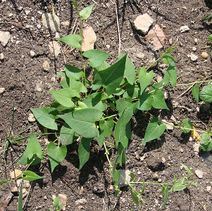Polygonum convolvulus
| Polygonum convolvulus | |
 | |
| Light: | |
| Moisture: | |
| Soil pH: | 5.6-8.4 |
| Self Pollinated | |
| Height: | 4' |
| Blooms: | Mid Summer-Mid Fall |
| Native to: | |
| Edible Rating: | |
| Tea: | Yes |
Polygonum convolvulus (common name: black bindweed) is a fast growing opportunistic climbing annual that produces a small, fiddly seeds that can be ground into a powder and used to make gruel or mixed with cereals.[1] The seed coat should be removed before use as it can cause indigestion.[2] This species contain oxalic acid which is reduced through cooking.[3]
Plant the seeds in situ in spring.
Cultivation: Succeeds in an ordinary garden soil[4] but prefers a moisture retentive not too fertile soil in sun or part shade.[5]
Plants seem to be immune to the predation by rabbits.[6]
Range: Europe, including Britain, from Norway south and east to N. Africa and temperate Asia.
Habitat: Waste places, arable land and gardens[7].
Pollinators: Insects, self
Soil: Can grow in light, medium, and heavy soils.
Flower Type: Hermaphrodite
Known Hazards: Although no specific mention has been made for this species, there have been reports that some members of this genus can cause photosensitivity in susceptible people.
Links
References
- ↑ Coffey, Timothy. The History and Folklore of North American Wild Flowers. Facts on File, 1993.
- ↑ Grieve, Margaret. A Modern Herbal. Penguin, 1984.
- ↑ Bown, Deni. Royal Horticultural Society Encyclopaedia of Herbs and Their Uses. Dorling Kindersley, 1995.
- ↑ Chittendon, Fred. RHS Dictionary of Plants. Oxford University Press, 1951.
- ↑ Huxley, Anthony. The New Royal Horticultural Society Dictionary of Gardening. MacMillan Press, 1992.
- ↑ Thomas, Graham. Perennial Garden Plants. J. M. Dent & Sons, 1990.
- ↑ Clapham, Arthur and Tom Tootin, Edmund Warburg. Flora of the British Isles. Cambridge University Press, 1962.